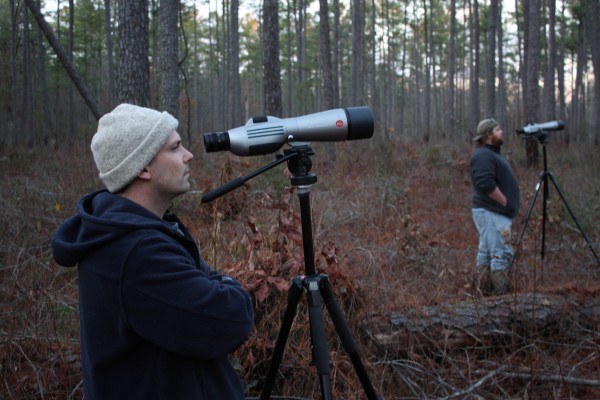Winter population count of red-cockaded woodpeckers
Monitoring shorebirds for Avian Influenza
January 11, 2009Friend & Conservation Partner, George Kinter: World traveler, birder & book collector
January 14, 2009
Written by Michael Wilson
January 12, 2009
The red-cockaded woodpecker is a federally endangered species that has disappeared completely from the northern portion of its breeding range. Virginia supports the only population north of the Carolinas where breeding has continued to the present time. However, both the number of sites and the population of birds have declined dramatically over the past 40 years and the species remains in eminent danger of extinction within Virginia.
CCB has been involved in a multi-organization partnership to monitor and manage the Virginia Populations since the 1970s. The latest installment of this work was the CCB’s completion of the 2008 winter population survey at The Nature Conservancy’s Piney Grove Preserve. This winter, we documented 7 active clusters that supported a combined total of 31 birds. Red-cockaded woodpeckers are cooperative breeders so the term “cluster” is used to describe a site where a group of nest cavity trees exist in close vicinity. The cluster is occupied by a clan of birds that work together during the breeding season. A single cluster typically contains the resident breeding pair and sometimes additional non-breeding helper birds that assist in feeding young during the breeding season and also help in excavating new cavities throughout the year. The clan of birds continues to forage together during the winter.

Researchers, Michael Wilson (left) and Fletcher Smith (right) monitor early morning red-cockaded woodpecker activity at The Nature Conservancy’s Piney Grove Preserve in Virginia. Photo by the Center for Conservation Biology.
The winter results included detections of 7 of the 8 birds fledged this past breeding season. Piney Grove Preserve is now supporting the highest number of known red-cockaded woodpecker clusters in Virginia since the late 1980s, when the population was in drastic decline. We have seen the number of potential breeding sites at Piney Grove grow by one cluster each year over the last four years.
In addition to the overall population growth, the red-cockaded woodpeckers at Piney Grove Preserve are beginning to settle into a more natural setting. When the Nature Conservancy purchased the land in 1999 there were only 3 clusters that contained birds. Each of these clusters was composed of natural cavity trees that were excavated directly by the birds. In order to bolster the population, artificial cavities were installed at additional sites on the Preserve and birds were translocated from populations in South Carolina and North Carolina. Over the past year we have seen the woodpeckers steadily moving away from the artificial cavity trees by excavating cavities of their own. In fact, every single breeding event at both natural and artificial sites in 2008 occurred in a cavity excavated by the woodpeckers themselves. We have seen the number of natural cavity trees grow again between the summer and the winter surveys and the population is losing its dependency on artificial cavities. The speed at which these birds excavate is of added interest. Red-cockaded woodpeckers only excavate cavities in living pine trees that are 80 years and older. Because drilling through thick sap layers and tree heartwood is difficult, cavity excavation time for most red-cockaded woodpeckers can take several years. However, Piney Grove is composed of a majority of loblolly pines with fewer shortleaf pines. The tissues of these tree species are generally more pliable for excavation compared to longleaf pine, which is the primary cavity tree species used by red-cockaded woodpeckers in the deeper southeast. As a result the Piney Grove woodpeckers are excavating new cavities in only a few months. We are constantly finding newly created cavities.
Work on this fragile population of endangered woodpeckers is supported by funds from the Virginia Chapter of The Nature Conservancy (TNC), the Virginia Department of Game and Inland Fisheries (VDGIF), and the Center for Conservation Biology (CCB). We will continue monitoring efforts in 2009 with a spring population count in April, breeding activity monitoring form May through July, winter count in December, and year-long monitoring of cavity trees.
Project sponsored by The Nature Conservancy, Virginia (TNC Virginia), Virginia Dept. of Game & Inland Fisheries (VDGIF), and The Center for Conservation Biology (CCB).



